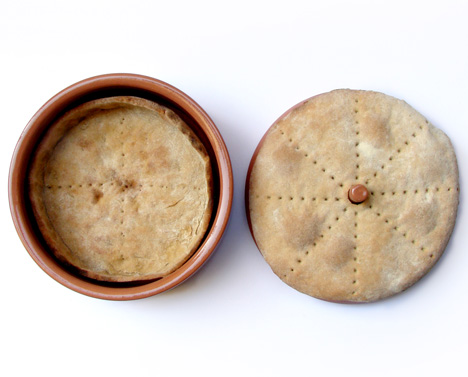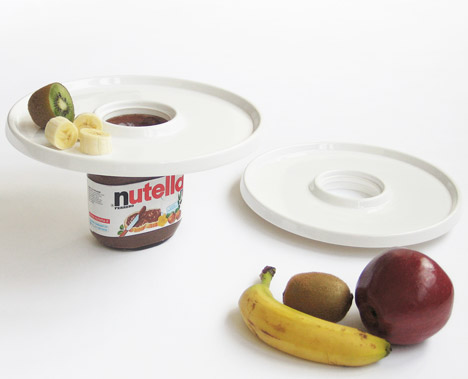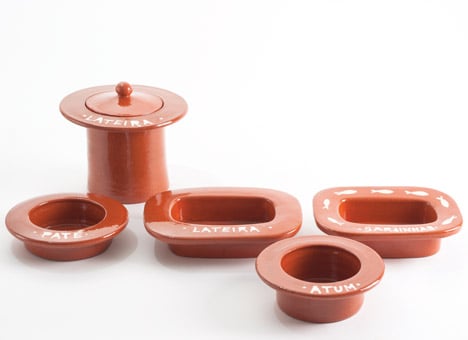Milan universities team up to launch "unique" food design degree
News: designers including Marti Guixè and Stefano Giovannoni will be among the teaching staff of a food design course being co-developed by one of Italy's leading design schools – an increasingly popular subject area for design education (+ interview).
The Milan-based Scuola Politecnica di Design (SPD) and International University of Languages and Media (ILUM) will combine forces to launch the Master in Food Design in March 2015, which they claim will be "unique on a world scale".
Comprising 11 teaching modules, the programme will bring together a teaching faculty of designers, academics, scientists, journalists, chefs and managers from the food industry.
"The main objective is to bring innovation to companies in the food sector and sectors related to it, and in my opinion the only way to do this is to get managers, designers and food technologists involved in a dialogue," SPD director Antonello Fusetti told Dezeen.
"Without design-oriented people, marketing people are insufficient in creating new products or providing clients with new experiences," he said. "The design world, meanwhile, needs to increasingly focus its attention beyond the traditional sectors of furniture and objects. The food industry not only offers them a great opportunity to experiment, but also to work."

Earlier this year, Design Academy Eindhoven appointed "eating designer" Marije Vogelzang to head up its new food department, which the Dutch school described as the first of its kind. Vogelzang said that her course would attract young people who want to "change the food chain and to change our perception to food".
SPD's degree aims to not only teach young students, but also offer retraining for designers and others who want to move their practice into food design.
It will define a "food designer" as someone able to manage all of the design elements for processing, distribution and consumptions of food, its aesthetic presentation, the creation of equipment and tools for preparation and consumption and "all the communication activities implemented for the promotion of food products".
The course is being sponsored by multinational soft drinks company PepsiCo, who will fund two scholarships – one covering the full cost of the course and a second offering 50 per cent of the necessary funding. The company will also offer internships to students.
"We strongly believe that applying design to the realm of food in a broad and holistic way, from food design to the design of a brand identity and its activations, can add great value to all businesses in this sector," said Mauro Porcini, chief design officer at PepsiCo.
Further partnerships will be announced before teaching begins next year.

Although lessons and lectures will be given in Milan, they will be taught in English to make them more accessible for international students. Students will be required to attend 580 hours of lessons and complete a three-month internship by February 2016.
"This is not intended to be a simple masters course in food design, as is the case with some other courses in Italy and throughout the world. This is meant to be 'the' Master Course in Food Design, with several unique aspects," said Fusetti.
Marti Guixè, the Spanish designer Fusetti credits with coining the term "food design", has created the visual identity for the masters (top image) and was one of the originators of the idea to launch a dedicated degree programme at SPD on the subject.
Guixè is a graduate of SPD, having studied there from 1986 to 1987, and has been designing food-related objects for more than 30 years.
"When Antonello Fusetti took the school, he approached me as one of the relevant ex-students," Guixè told Dezeen. "But it is only now when the food industry and the social sensibility towards food innovations are more open to start thinking about food in a more contemporary way, and to develop a design project with it."
"I am a kind of catalyst, and I will have one of the main roles on the masters, also if only as a kind of stalker," he added.
Guixè will be joined on a teaching staff by Italian industrial designer Stefano Giovannoni, whose projects include a wide range of food-related appliances produced during a decades long collaboration with design brand Alessi.
"There's also Design Group Italia, which has an internal Food Lab," explained Fuesetti. "In addition to these, I assure you that all the designers who have carried out interesting projects related to food, as well as the most innovative food designers, will bring their contribution to this master course by giving lectures."

Read our Q&A with Antonello Fusetti, director of Scuola Politecnica di Design SPD Milano:
Anna Winston: Why are launch a food design course now?
Antonello Fusetti: We often talk about Food Design but we have been lacking a very qualified educational initiative whose goal is to train a new generation of professionals, designers and managers able to combine management, marketing and communication skills with design methodology and sensibility. The main objective is to bring innovation to companies in the food sector and sectors related to it, and in my opinion the only way to do this is to get managers, designers and food technologists involved in a dialogue.
Without design-oriented people, marketing people are insufficient in creating new products or providing clients with new experiences. The design world, meanwhile, needs to increasingly focus its attention beyond the traditional sectors of furniture and objects. The food industry not only offers them a great opportunity to experiment, but also to work. We mustn't overlook the fact that there are also employment opportunities in this sector. Our sponsor Pepsi bears witness to this fact, having created an organisation with over a hundred people dedicated to design.
Graduates of the masters course will be able to work in businesses throughout the whole food supply chain, from food production to food distribution. And not only these. They will also find outlets in all the companies and institutions related to the food sector. Think of the companies and design firms that produce kitchens, objects and equipment for the preparation and consumption of food; interior design studios focused on designing restaurants and food markets; companies dealing in packaging, communication, marketing and the organisation of culinary events; municipalities, regions and tourist areas interested in designing food and wine tours.
The masters course will take place in conjunction with Expo 2015 and Milan, the capital of design, will also become the capital of food during that time. We believe, therefore, that this kind of masters course could only have arisen in Milan. We also want the course to branch off into a permanent laboratory of experimentation and consultancy in the food design industry, to foster innovation in the agricultural and food sector.
Anna Winston: How is this different from what other design schools are doing?
Antonello Fusetti: This is not intended to be a simple masters course in food design, as is the case with some other courses in Italy and throughout the world. This is meant to be "the" Master Course in Food Design, with several unique aspects.
The programme is innovative in that it deals with the full spectrum of food design and does not focus on a single topic, as other courses do. The lecturers are very prestigious and are the most interesting and most famous people in their areas of expertise: not just designers, but also chefs, food critics, and entrepreneurs and managers from food companies.
The course will be very practical, with design workshops in which five projects will be developed. It's a university masters degree so it will be recognised by the Ministry of Education.
Anna Winston: Which designers will you be working with as teachers?
Antonello Fusetti: The teachers will first of all include those who urged me to create this initiative from the very beginning. I'm referring to Marti Guixè, author of the visual we are using for the masters course and who I think could be considered the first designer to experiment with food, over thirty years ago, and we mustn't forget that it was he who actually coined the term 'food design'.
Then there's Stefano Giovannoni, who is perhaps the designer with the largest number of designs of objects related to cooking and food (several hundred), and who has sold millions of items. You need only think of his many projects for Alessi, for example. There's also Design Group Italia, which has an internal Food Lab. In addition to these, I assure you that all the designers who have carried out interesting projects related to food, as well as the most innovative food designers, will bring their contribution to this master course by giving lectures.
Anna Winston: What will the course consist of? Will students have access to special facilities?
Antonello Fusetti: The programme will be charactersed by a multidisciplinary approach, have a strong professional orientation and offer a balanced combination of lectures, design workshops, testimonials and excursions, alongside an introduction to the food and agricultural system, food technologies, and food and wine culture. Specifically, the course will include 11 Teaching Modules:
The Food and Agriculture System, Food Science, Food and Wine Culture, Food Marketing & Communication, Food Experience, Food Design, Food Design: designing food and objects, Food Design: food venues, Food Design: packaging, Food Service Design, Food Design and Tourism.
The masters course is open to Italian and International university graduates and will be taught in English. It will begin on 30th March 2015 and will finish in February 2016. This period also includes a three-month internship for all students.
Pepsi will also play an active role in the course by entrusting the students with several briefs aimed towards developing innovative projects during workshops.
Anna Winston: Why is this a design subject rather than a science or marketing subject?
Antonello Fusetti: The food industry can, in fact, be examined from a scientific point of view – food science – as well as from a marketing, management or design perspective. To create innovation, we need to combine all three of these areas, not just the first two. Let's not forget that food appears to be increasingly removed from its nutritional functions, and has also taken on aesthetic, symbolic and communicative values. Furthermore, the current competitive system, new consumer needs and new technologies require the development of occupations that are increasingly able to provide innovative contributions, even in the food sector.